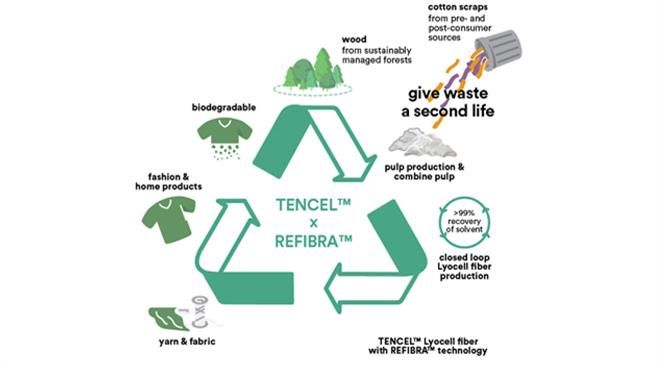Target at Lenzing to reach carbon neutrality by 2050
The Lenzing Group produces Lenzing lyocell and modal cellulosic fibres of botanic origin through environmentally responsible processes from the sustainably sourced natural raw material wood. Florian Heubrandner, Vice President Global Business Management Textiles of Lenzing AG, speaks to Fibre2Fashion about the company's latest breakthrough in Refibra technology and its vision to produce fibres with Refibra technology using up to 50 per cent recycled content from post-consumer cotton waste.
What is the world market share of Lenzing as a producer of specialty fibres made from renewable raw material wood? Who are your biggest competitors?
Lenzing's overall market share in wood-based cellulose fibres is roughly 15 per cent. Our specialty products Lenzing Ecovero, Tencel branded lyocell and modal fibres are one of the most sustainable branded fibres, possessing multiple functional benefits and versatility.
As awareness in sustainability becomes more prominent across the textile industry, more and more types of eco-friendly materials and companies have joined the market. We are really pleased to see more industry players joining in the value chain, making serious commitments to use more sustainable materials and embracing the eco-movement. At Lenzing, we have over 80 years of experience in producing wood-based sustainable fibres, making us confident that our high-quality premium products and forward-thinking commitments to the environment will keep us on the cutting edge of the sustainability movement. We look forward to continuing to build a more sustainable textile ecosystem for the future.
What are the major distinctions between your Tencel, Lenzing Ecovero and Veocel fibres in terms of composition and end use? What is your total production capacity of fibres?
At Lenzing, all our fibres are produced from sustainable sourced wood pulp and are very versatile when it comes to different applications.
For instance, Tencel branded lyocell and modal fibres are adopted across various textile subsegments from denim, innerwear, activewear, outerwear and home textiles. We also offer lyocell fibres with Refibra technology as a special category, which adopts both pre and post-consumer waste for recycling. Lenzing Ecovero branded fibre is a new type of clean viscose, which is an ideal sustainable alternative to conventional viscose used in textile production. Lastly, Veocel branded fibres are used in the nonwoven segment and are ideal for adoption in hygiene and personal care products, predominantly.
Our total fibre production capacity reached over 1 million tonnes in 2018 and we will continue to expand, producing comfortable and high-quality preferred fibres for different industry usage, setting the benchmark for industry sustainability.

Which of the above 3 fibres is in most demand?
All three fibres enjoy very strong demand as they cater to different segments and applications. In the textile segment, Tencel branded fibres have grown into a popular material for fashion and home wear. Lenzing Ecovero branded fibres are also used in the textile segment, offering a sustainable viscose alternative to the industry. For hygiene and personal care products, our Veocel branded fibres are the ideal sustainable alternative for the nonwovens. With sustainability in our DNA, we are dedicated to working with brands and partners across different industries all of whom are making commitments to work towards a sustainable future.
Where do you source your bio-based raw materials from?
Our fibres originate from renewable raw material wood, from sources including beech, spruce and eucalyptus. More than half of these trees are grown across Europe and processed in our own plants located in Lenzing, Austria and Paskov, Czech Republic. The remaining volume is sourced from international partners, certified according to recognised criteria such as the FSC and PEFC standards.
You recently upgraded your breakthrough Refibra technology. What drove you to further upgrade it? How is it going to further strengthen your commitment to the circular economy in textiles?
By launching Refibra technology in 2017, Lenzing executed the concept of recycling with a new generation of specialty fibres. Since then, we have been driving towards a recycling process which also incorporates post-consumer waste.
With increased public awareness of circular economy and the booming demand for sustainable solutions, we have been continuously innovating our recycling technologies to meet the pace of the industry's eco-movement. As a result of ongoing research, in September 2019, the first phase of the Refibra technology upgrade saw an increase in the composition of recycled pulp to 30 per cent. Given the recency of this achievement, we are incredibly proud to launch a second upgrade in which up to 10 per cent of the 30 per cent recycled raw material content can be made from post-consumer cotton waste.
By leveraging the Refibra technology breakthrough, Lenzing has also been working closely with brands and industry stakeholders to pursue a more collaborative transition towards greater inclusive and circular economic growth. We will continue to stand at the forefront of the industry to assist businesses with the implementation of eco-practices in their operations.

What positive impacts are expected after upgrading the technology? What will be the carbon footprint?
Currently, most of the textile waste still comes from clothes thrown away by consumers and finding a practical way to work with post-consumer waste is a significant step towards circularity. The new generation of Refibra specialty fibres features 10 per cent post-consumer waste in its recycled component, a significant development and the industry's first move to produce on a commercial scale.
Carbon footprint during the Refibra production process is minimal and is recommended by the World Economic Forum as a pioneering solution to tackle the textile industry's waste problem. During the recycling process, liquor streams are internally recycled to ensure efficient use of energy and chemicals and the recycled pulp is used as a raw material to produce lyocell fibre in an efficient closed loop production process.
Your vision is to produce fibres with Refibra technology by having up to 50 per cent recycled content from post-consumer cotton waste to make textile waste recycling as common as paper recycling. How do you plan to achieve this? What steps will you be taking in this direction and what collaborations are required for the same?
Our industry is reaching a crucial tipping point given the fashion industry's negative impacts on the environment. To change this situation, our industry needs to undergo systematic changes to have positive effects on the future of fashion, and our environment.
At Lenzing, we regularly engage a series of brands and retailers to integrate different perspectives, which helps us to better understand global trends, and mitigate risks. Through these knowledge exchanges, we are able to connect with like-minded industry stakeholders and forge strong collaborations. These partnerships allow us to collect inventory and old garments from associates' stores for Refibra processing. In addition, we also work with sorting and collection companies, such as Canopy, to source post-consumer waste.
On the demand side, to create more exposure, we have been actively involved in various consumer initiatives. From launching the #MakeitFeelRight consumer campaign to our co-branding series, we are confident that we are making a difference in amplifying the awareness of sustainability and circularity among spenders.
Where are the products made from Refibra fibre technology being currently offered at?
Tencel's Refibra lyocell fibres are now featured in more than 15 collections worldwide, from activewear, denim to home wear. Lenzing will continue to work with our brand partners to improve the functionality and versatility of the fibres, making them available in more products and more consumers.

What is the feedback you have received from your partners who are using fibres produced by Refibra technology?
We have received very positive feedback from our brand partners. With the recycling value further enhanced after recent upgrades in our technology, our partners can now offer more to consumers who would like to shop consciously. Quality-wise, despite having gone through a recycling process, fibres produced by Refibra technology possess a high standard of functionality similar to other premium wood-based fibres.
Apart from Albania, are you taking on any other sustainability project in any other region/regions around the world as part of the sustainability strategy 'Naturally positive'?
With more concerns over environmental issues brought by the textile industry, it is important for us to continue leverage our innovation and expertise to lead the industry and drive for sustainability at roots. We take a lot of pride in our sustainability leadership and have been very committed in launching key sustainable initiatives both internally and externally.
Internally, we have set out various sustainability goals within Lenzing, and one of the most important targets is to reach for carbon neutrality by 2050. This target has been validated by Science Based Targets initiative, one of the most recognised organisations in the field of climate-relevant target setting. For the Tencel brand, we are also finding ways to better implement Lenzing's sCore TEN strategy within the textile segment. This means further driving growth of our specialty fibres across different geographies and segments (i.e denim, activewear, home, inner and outer wear) with our sustainable specialty fibres portfolio.
Externally, we have also been launching and planning different eco-friendly initiatives based on collaboration with value chain partners globally, to uphold our strategy and deepen our connection with local consumers.
We are really excited about the future of driving an eco-friendlier world and will continue to develop more comfortable and high-quality preferred fibres that set ever higher benchmarks for industry sustainability.
Is your blockchain platform meant to support Tencel branded fibre business operational yet? Can you elaborate more on Lenzing's strategy of using blockchain technology to support the business?
Yes, our blockchain platform is operational already. We've been conducting several pilots with brand partners and are aiming for a roll-out later this year. Sustainability has been the guiding torch for all innovation initiatives at Lenzing and adopting blockchain is a pivotal part in stepping up our pledge and looking to the future in this new decade of fashion sustainability.
Through the blockchain technology, we will be able to maximise the digital traceability of fibres, allowing not only brands and designers but also consumers to identify the origins and production process of garment raw materials, which is vital for an eco-friendly fashion industry.

What are the future plans of Lenzing to keep driving circular economy?
Circularity is one of our key sustainability pillars, which will continue to be central to our research and technology innovation in the future, and the ongoing development of the Refibra technology will continue to be our top priority.
Lenzing's five-year vision is to raise the industry bar by producing fibres with Refibra technology using up to 50 per cent recycled content from post-consumer cotton waste and to make textile waste recycling as common as paper recycling. To achieve this, we will continue to focus on how to improve the efficiency of sourcing post-consumer waste as well as extending our outreach to more brands and retailers, with the aim of reaching new sustainability heights in our industry. (PC)







